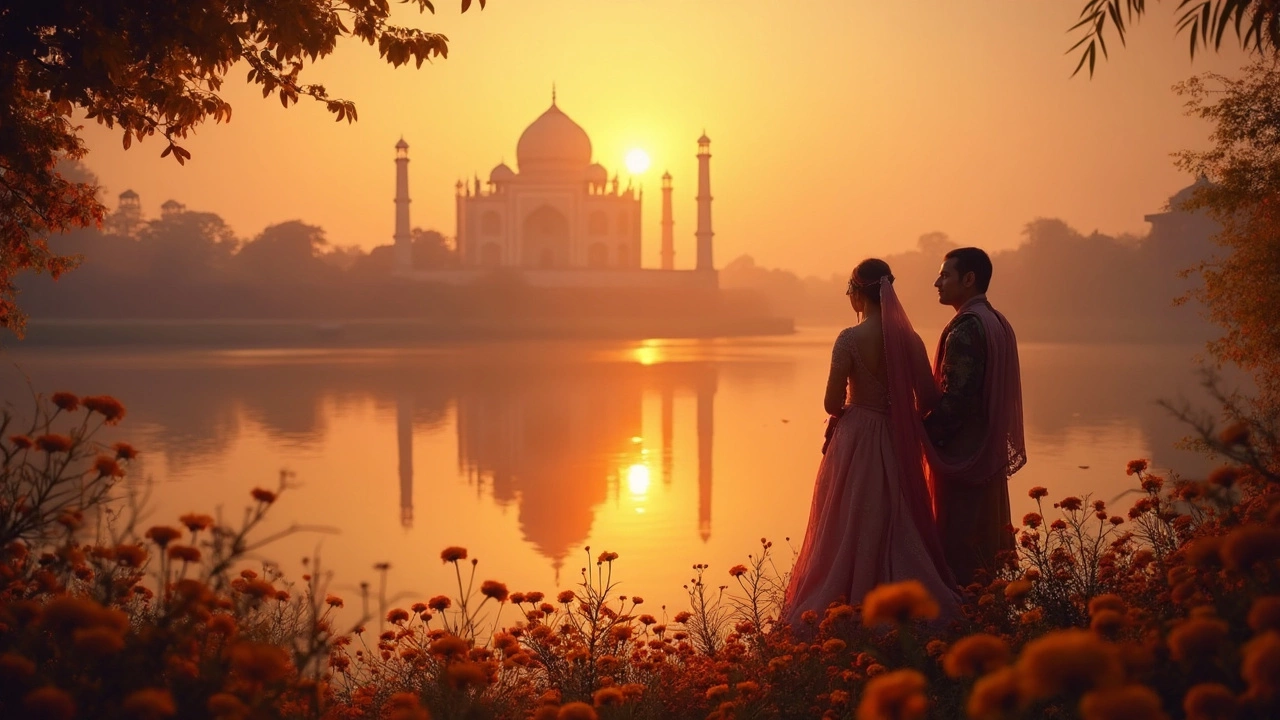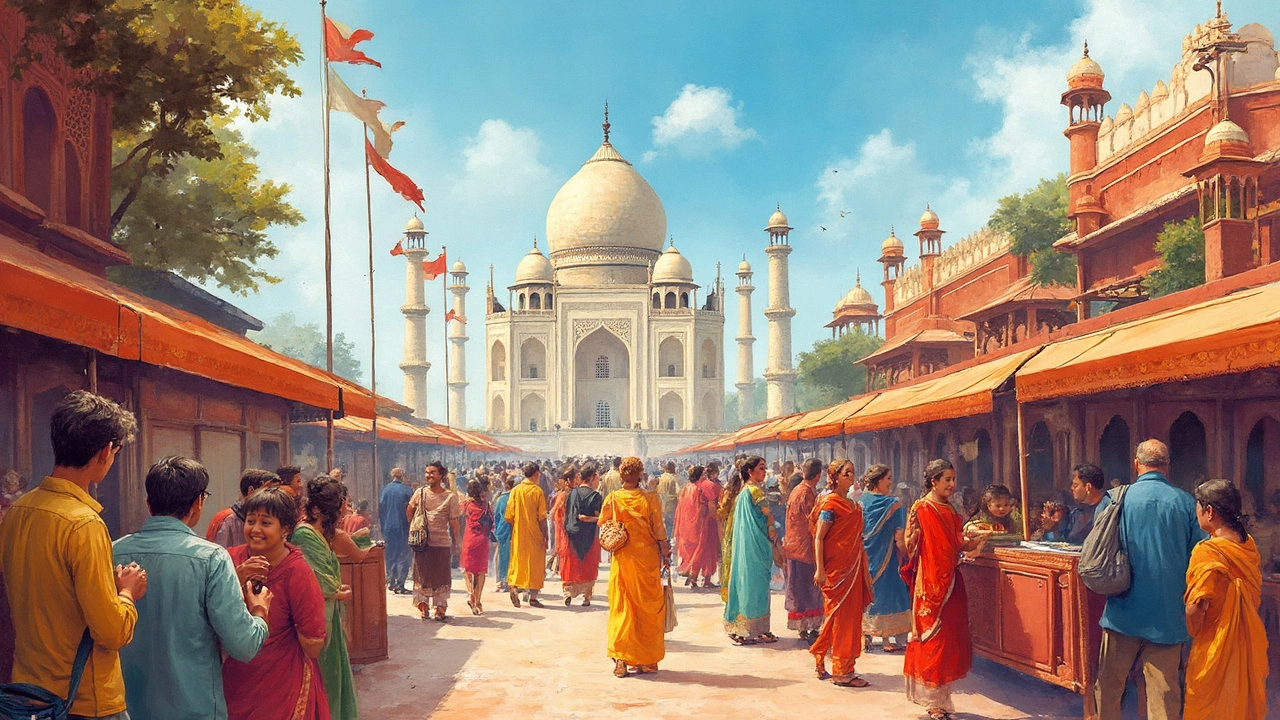So, you're thinking about visiting India’s Golden Triangle, huh? Great choice! This route—linking the bustling streets of Delhi, the awe-inspiring Taj Mahal in Agra, and the colorful bazaars of Jaipur—is on many travelers' bucket lists. But when's the best time to hop on this journey?
As you may know, the weather in North India can be pretty unpredictable. Trust me, you don't want to be wandering around the Taj Mahal in 45-degree Celsius heat. That's where timing comes into play. Most folks say the sweet spot is between October and March. The weather is cooler, which makes exploring way more comfortable.
But hey, it's not just about comfortable weather. There are loads of festivals and events during these months too. Imagine watching traditional dance performances or tasting local treats during Diwali in Delhi—it's an experience you won't forget.
- Understanding the Golden Triangle
- Weather Conditions Throughout the Year
- Cultural Events and Festivals
- Avoiding the Crowds
- Personal Tips for an Enjoyable Trip
Understanding the Golden Triangle
The Golden Triangle India isn't a geographical term but a legendary travel circuit that forms a triangle on the map, connecting three of India's most vibrant and culturally significant cities: New Delhi, Agra, and Jaipur. This route showcases a spectrum of India's heritage, making it a favorite for both history buffs and casual travelers.
Let's start with New Delhi, the pulsating heart of India. It's a place where the ancient and the modern worlds seamlessly blend. You can explore historic landmarks like the Qutub Minar and India Gate, or dive into some spicy street food at Chandni Chowk.
Next, Agra. The moment you hear Agra, the Taj Mahal probably pops into your mind. It's more than just a building; it's a symbol of love and architectural genius. But Agra isn't just about the Taj. The city is also home to Agra Fort and the quaint beauty of Itmad-ud-Daula's Tomb.
Finally, Jaipur. Known as the Pink City, it enthralls with its vibrant buildings and rich history. Places like the Amber Fort and Hawa Mahal are a must-see. Jaipur isn't just about palaces and forts; it's a cultural feast with its bustling markets and vibrant festivals rallying on the streets.
| City | Must-See Attractions |
|---|---|
| New Delhi | Qutub Minar, India Gate, Chandni Chowk |
| Agra | Taj Mahal, Agra Fort, Itmad-ud-Daula's Tomb |
| Jaipur | Amber Fort, Hawa Mahal |
Traveling through the Golden Triangle gives you a taste of India’s diversity in a manageable package. Whether you're discovering Mughal history in Agra or bargaining in Jaipur's bazaars, you're in for a memorable ride.
Weather Conditions Throughout the Year
When planning a trip to the Golden Triangle in India, understanding the weather is key to having a good time. This part of India has three main seasons: summer, monsoon, and winter. Knowing what to expect in each can really help you decide when to go.
The summer months, from April to June, can be brutally hot. Temperatures in places like Delhi and Agra often soar past 40°C (that’s over 100°F!). Unless you're a fan of sweating bullets, this might not be the ideal time for sightseeing.
Next up is the monsoon season, which hits around July and lasts till September. While temperatures drop a bit, be prepared for heavy rains, especially in Jaipur. The rain can both beautify and complicate your trip. If you like a bit of adventure and don’t mind getting drenched once in a while, this time might offer a different kind of charm.
Winter is when the Golden Triangle truly shines. From October to March, the weather is cooler, making travel around New Delhi, Agra, and Jaipur way more pleasant. Think of roaming around in 20-25°C (68-77°F) temperatures—pretty nice, right?
During these months, you can enjoy easier walks through crowded markets, explore the great outdoors without breaking a sweat, and even partake in some of the local festivals. So, when someone asks, "When’s the best time to visit the Golden Triangle?" winter is usually the answer.
To sum it up, each season has its pros and cons, but for comfy sightseeing and to avoid melting in the heat, winter’s your best bet. Just a little planning on the weather front can make your North India tourism experience a whole lot better.

Cultural Events and Festivals
Diving into the Golden Triangle during festival seasons is like adding an extra layer of magic to an already enchanting trip. The entire region comes alive with color, music, and joy, as locals and tourists get together to celebrate.
One of the most vibrant times to visit is during Diwali, usually between October and November. Known as the Festival of Lights, Diwali turns the streets into a sparkling wonderland, especially in Delhi, part of the Golden Triangle India. People decorate their homes with diyas (small oil lamps), and markets buzz with excitement. You'll witness amazing firework displays and get a taste of delicious sweets.
If you swing by around March, you might catch Holi, the Festival of Colors, in full swing. This is celebrated with much enthusiasm in Jaipur. Picture this: everyone throwing colored powders at each other in a joyous celebration, creating a stunning mosaic in the streets. Just remember to wear clothes you don’t mind getting stained!
And let's not forget about the Pushkar Camel Fair, held every November. While it’s slightly on the edge of the Golden Triangle, it’s worth the detour if you're into unique cultural experiences. This fair features camel trading, folk performances, and even a camel beauty contest!
Timing your visit around these festivals not only enhances the experience but also gives insight into the rich cultural tapestry of North India tourism. Keep an eye on the festival calendar and plan ahead—you wouldn't want to miss these colorful celebrations!
Avoiding the Crowds
Visiting the Golden Triangle India is on many travel bucket lists, which means you're not going to be alone. If you want to avoid the throngs of tourists while exploring Delhi, Agra, and Jaipur, timing and a little strategy can go a long way.
First things first, try to steer clear of major holiday periods like Diwali and peak winter season from Christmas to New Year's. During these times, both international and domestic tourists flock to the sites, which means longer lines and packed spaces.
For a more relaxed experience, consider hitting the sites early in the morning. The Taj Mahal opens at sunrise, and not only is the light amazing for photos, but the crowds are thinner too. Plus, starting early means you can enjoy a peaceful stroll around the grounds before the heat kicks in.
Another tip? Opt for weekday visits instead of weekends. Many local families plan their trips for Saturdays and Sundays, making popular spots busier. Midweek, you'll find a bit more breathing room.
Check if there's a lesser-known entrance. At places like the Taj Mahal and historical forts, smaller entrances can lead you to areas with fewer tourists.
Lastly, consider visiting during the shoulder months of September and April. The weather's still nice, and there's a slight dip in tourist numbers. It's the perfect time to snap that iconic Taj Mahal shot without someone's selfie stick photobombing your moment.
Here's a quick list to avoid the crowds effectively:
- Visit during early mornings or late afternoons.
- Avoid public holidays and weekends.
- Consider off-peak travel months.
- Use lesser-known entrances when available.
Being savvy about when and how you visit can make your trip that much more enjoyable. You deserve a laid-back adventure, not a stress fest, right?

Personal Tips for an Enjoyable Trip
Okay, you've decided to explore the Golden Triangle India. Great decision! Here are a few personal tips to make your adventure smooth and memorable.
First things first, let's talk about packing. It might sound basic, but packing right can make or break your trip. If you're traveling between October and March, a light jacket will be your best friend. Mornings and evenings can get a bit chilly, especially in Jaipur. Don't forget comfortable walking shoes because you'll likely be doing a lot of walking as you explore all the sights.
Traveling within India means dealing with crowds, but you can avoid the worst of them by planning your visits to major attractions, like the Taj Mahal, early in the morning. Not only will you dodge the throngs of tourists, but you'll also catch some amazing views as the morning light hits. Sounds worth waking up early for, right?
Food can be a highlight, or for some, a stomachache waiting to happen. To play it safe, eat where you see good crowds. Many locals and tourists choosing a spot means the food is fresh and generally safe. You don't want to spend your trip hugging a toilet, believe me.
Here's a little nugget for the money-wise traveler: try using local transport options like rickshaws or the metro. It's not only budget-friendly but also gives you a genuine feel for how locals buzz around the city. Just make sure to negotiate your rickshaw fare before hopping in, as prices can be somewhat of a wildcard.
Lastly, stay connected! Grab yourself an Indian SIM card—it's cheap and super handy for navigation and keeping in touch with folks back home. You'll thank yourself when Google Maps saves you from getting lost in those narrow Jaipur lanes.
